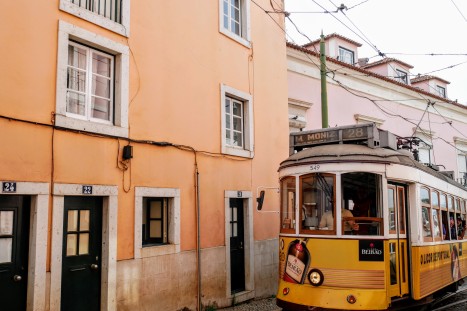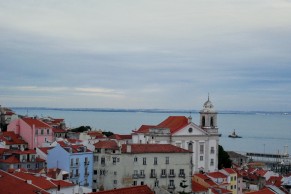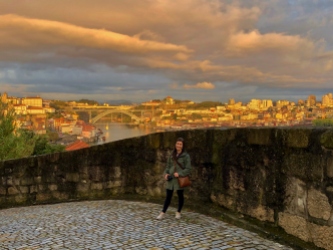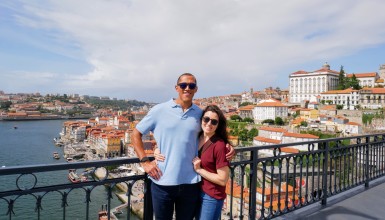On a recent visit to Portugal, we had the impossible task of taking in as much as possible in three days. Between enjoying fresh seafood, savory Francesinhas, and sweet Port wine, we traversed a few of the seven hills of Lisbon and crossed the striking blue bridge of Porto, discovering for ourselves why Portugal recorded the highest growth in tourism across Europe in 2018. Even after our short visit, it’s easy to understand why we aren’t the only ones who think this place is pretty great!
Our Friday flight from cool and dreary Brussels took us to warm and dreary Lisbon, but as we arrived in the city center, the rain was clearing and the colorful pastels of the city were emerging from the fog. We dropped our bags off at our Airbnb in the historic Alfama neighborhood and moved to the Copenhagen Café for brunch and a temporary workspace until the apartment was ready.

While Dan worked from our spacious apartment in the afternoon, I headed out on my own to explore Lisbon, starting with the many steep steps of Alfama, riverside promenade of Cais do Sodré, and street art of Bairro Alto. Lisbon is located on the Tagus River which drains into the Atlantic Ocean about 13 miles away – this access being instrumental to the Portuguese during their years as a worldwide sea power. The Alfama neighborhood of Lisbon is known for being the oldest area of the city. Historically outside of the city walls, it was associated with the poorest of residents. Following renovations, it is now famous for its charming crooked streets, popular #28 tram, and colorful tiling on the buildings.
I figured that if it was just me, I was going to wander as I pleased with only a couple planned stops in mind. While the #28 tram rattled past me transporting tourists and locals alike up and down the hills, I took pictures of cool doors, gorgeous walls of azulejos (Portuguese tiles), curving passageways, and pleasing panoramas. I slowly walked through Alfama towards the river, stopping first at the Miradouro de Santa Luzia viewpoint over the city and then the Sé de Lisboa (Lisbon Cathedral). Constructed in 1147, this cathedral was built on the site of a former Moorish mosque, the ruins of which were excavated and are now visible inside the church.
Reaching the vibrant yellow Praça do Comércio square, I asked a friendly couple for a few pictures before meandering along the water towards the Bairro Alto area of town. The impressive Praça do Comércio is the site of the former Royal Palace that, along with the largest collection of Portuguese literature housed within, was destroyed in the infamous 1755 earthquake. This massive earthquake actually extolled significant damage across the city, but the infallible Alfama, along with a few other neighborhoods, was left unscathed.

The Sant’Anna tile store was on my radar and I knew that while out by myself, I’d have some uninterrupted time to rummage through the misfit hand-painted tiles for a selection that caught my eye for decorative purposes. This tile manufacturer has been in the business of artisan tile crafting since 1741, with their factory located nearby in Belém. What is so special about these often blue and white tiles that decorate churches, shops, and train stations throughout the country? Azulejos are painted ceramic tiles with deep ties to the Iberian Peninsula, used both for decorative and functional purposes (cooling properties). Portugal’s own mass production didn’t occur until the 17th and 18th centuries, but the tradition of production of these iconic polished stones is intertwined with both the Arabic (“azulejo” is derived from Arabic) and Dutch cultures (the iconic blue and white comes from Delft).
The sun having come out, and now toting my recent tile purchases on my arm, I worked up a sweat climbing up several hills as I slowly made my way back towards the Airbnb taking the scenic route along the base of Castelo de São Jorge.
I stopped by the apartment to pick up Dan and we headed out to sample some local treats before dinner. Our first stop was for the pastéis de nata from the small but busy Manteigaria. There was a line out the door when we arrived but we learned that it moved quickly because your choices are limited. Customers simply need to decide if they are in need of coffee or espresso, want to eat in or take away, and just how many pastries they can eat in one sitting. When you have a reputation for your pastéis de nata, there isn’t much of a need to serve anything else to satisfy your patrons. So in exchange for two euros, we were handed a to-go box built for two of the Portuguese custard tarts that have a flaky crust and sweet custard filing. Looking to wash the egg tarts down with some sips of the local Ginjinha, we made our way to A Ginjinha, another small but bustling shop that serves the sour cherry liquor to go in a shot glass. No need to drink it like a shot though, instead, sip the smooth liquor and when you get to the bottom, give the liquor infused sour cherries a try!
Walking up towards Castelo de São Jorge we were on the lookout for more local specialties, and so it was that we found ourselves at Tomés Café Bar in Alfama ordering vinho verde (translated as green wine). Green wine is not actually green (news to me!), but rather gets its name from the lush green landscape of the Minho province in which it is produced. While chatting over wine with the server, we were invited to sign our names on the wall as hundreds had done before us. The majority of the walls being already covered in signatures and amateur art, I elected Dan to select a high spot near the ceiling for our Wisconsin [muffin] drawing and signatures. We then headed out for dinner at Beco a Serio, another find by Dan that served incredible octopus and steak.
While walking back to the Airbnb that night I noticed that hanging on the walls of some of the houses in the neighborhood were black and white photos of individuals with scrawled names. It was then that I recalled reading about the efforts underway to bring attention to the older residents of Alfama who have lived there their entire lives and witnessed the area turnover to new investors and tourists but still maintain a sense of community. We witnessed these communal ties as we passed by residents leaning from their windows to yell to their neighbor on the street and locals deep in conversation over coffee at the small corner cafes.

While listening to late night Fado music in Bairro Alto would have been preferred, with only one weekend between us and our upcoming 28km race, an early morning training run dictated an earlier evening. The next morning, we discovered that Lisbon has a beautiful and expansive promenade along the river which motivated us to head out of the city center towards the Ponte 25 de Abril. The bridge is strikingly similar to the Golden Gate Bridge due to its comparable color.

Our route took us towards Belém, but not as far as the Atlantic, before we turned back to ensure that we had time for a quick lunch at the Copenhagen Café ahead of our train. Dragging even our smaller wheeled carry-on suitcases up and down the hilly streets is hard work but we managed to (barely) make the high-speed train that would deliver us in Porto in under three hours.
Fortunately, the rain started after we were comfortably settled into our seats on the train, but unfortunately it didn’t stop when we arrived in Porto so the second stop of our trip got off to a wet start (see pic below). We were undeterred though and used the rainy weather as an excuse to enjoy our Airbnb apartment which was situated in a perfect spot with beautiful views of The City of Bridges.
At the recommendation of friends (thanks Natalie & Rob!), we had made a reservation for a port house tour and tasting at Graham’s Port Lodge that evening. The port houses of Porto are located on the south side of the Douro River in Vila Nova de Gaia, so we found ourselves in a cab crossing one of the six bridges of Porto to reach the tour just in time. Not knowing much about Port ourselves, our knowledgeable guide enlightened us on the Douro valley region, which is famed for its durable grapes, the difference between a ruby, tawny and a vintage, as well as how to pair it with cheese and chocolate. Aren’t we fancy now?
The rain having stopped, we made our way to dinner on foot, this time meandering through the streets of Vila Nova de Gaia and crossing over the lower level of the famous double-decker Ponte Luis I before having to climb the stairs back up on the other side in Porto. If the bridge reminds you of the Eiffel Tower (see pic below), that’s because it was designed by a disciple of Gustave Eiffel in 1886, only three years after the Eiffel Tower, in fact. The views from both the upper and lower level are impressive and in high demand by visitors.

At dinner at Arcos das Verdades that night, we sampled more port with our local cuisine, including Dan’s favorite sandwich of all time – the Francesinha. Made with bread, ham or steak, and cheese, a thick tomato sauce covers the top and drowns the sandwich in flavorful goodness. It was so good we ate the entire thing before I could even get a picture of the delicious behemoth.
Waking up to clear skies the next morning was uplifting, as was our delicious breakfast spread at Do Norte Café by Hungry Biker. Another successful culinary find by Dan, we were energized for the day of touring ahead by our massive spreads, only to be disappointed that we wouldn’t be able to tour the iconic Bell Tower or Crystal Palace. Porto is a popular tourist spot, so I guess we shouldn’t have been that surprised that tickets would be hard to come by or not available until after our departure time. Instead, we did some wandering around Porto before heading back to the Ponte Luis I to walk across the upper level of the bridge for a glass of Port on the other side.

Careful to avoid the metro that also crosses the Douro River via the upper level of the bridge, we then descended to the docks to partake in a crowded but enjoyable boat tour to see the six bridges and almost make it out to the Atlantic Ocean.
We squeezed in one last meal of delicious Portuguese food before making our way to the airport. For not the first time during our travels, we agreed that another country had made its way onto our list of places we would need to visit again. I don’t think it’s too bold of me to say that Portugal offers something for everyone – beautiful coasts, gorgeous countryside, enticing cities, delicious cuisine, and all around affordable travel. We can’t seem to find the Francesinha in Brussels, so I’m sure we will be back sooner rather than later.






























